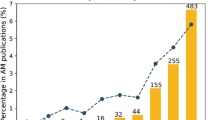Abstract
Machining process modeling, simulation and optimization is one of the kernel technologies for virtual manufacturing (VM). Optimization based on physical simulation (in contrast to geometrical simulation) will bring better control of a machining process, especially to a variant cutting process – a cutting process so complex that cutting parameters, such as cutting depth and width, change with cutter positions. In this paper, feedrate optimization based on cutting force prediction for milling process is studied. It is assumed that cutting path segments are divided into micro-segments according to a given computing step. Heuristic methods are developed for feedrate optimization. Various practical constraints of a milling system are considered. Feedrates at several segments or micro-segments are determined together but not individually to make milling force satisfy constraints and approach an optimization objective. After optimization, an optimized cutting location data file is outputted. Some computation examples are given to show the optimization effectiveness.
Similar content being viewed by others
References
Agapiou JS (1992) The optimization of machining operations based on a combined criterion: I. The use of combined objectives in single pass operations. J Eng Ind 114:500–507
Armarego EJA, Smith AJR, Wang J (1994) Computer-aided constrained optimization analyses and strategies for multipass helical tooth milling operations. Ann CIRP 43(1):437–442
Chang TC, Wysk RA, Davis RP, Choi B (1982) Milling parameter optimization through a discrete variable transformation. Int J Prod Res 20(4):507–516
Chiang S-T, Liu D-I, Lee A-C, Chieng W-H (1994) Adaptive control optimization in end milling using neural networks. Int J Mach Tools Manuf 34(5):637–660
Dereli T, Filiz IH, Baykasoglu A (2001) Optimizing cutting parameters in process planning of prismatic parts by using genetic algorithms. Int J Prod Res 39(15):3303–3328
Ehmann KF, Kapoor SG, Devor RE, Lazoglu L (1997) Machining process modeling: a review. J Manuf Sci Eng 119(11):655–663
El Mounayri H, Spence AD, Elbestawi MA (1998) Milling process simulation – a generic solid modeler based paradigm. J Manuf Sci Eng 120(2):213–220
Feng HY, Su N (2000) Integrated tool path and feed rate optimization for the finishing machining of 3D plane surfaces. Int J Mach Tools Manuf 40:1157–1572
Lawrence Associates (1994) Virtual manufacturing technical workshop
Li ZZ, Zheng M, Zheng L, Wu ZJ, Liu DC (2003) A solid model-based milling process simulation and optimization system integrated with CAD/CAM. J Mater Process Technol 138(1–3):513–517
Lim EM, Menq CH (1997a) Integrated planning for precision machining of complex surfaces: I. Cutting-path and feedrate optimization. Int J Mach Tools Manuf 37(1):61–75
Lim EM, Menq CH (1997b) Integrated planning for precision machining of complex surfaces: II. Application to the machining of a turbine blade die. Int J Mach Tools Manuf 37(1):77–91
Petropoulos PG (1973) Optimal selection of machining rate variables by geometric programming. Int J Prod Res 11(4):305–314
Smith S, Tlusty J (1991) An overview of modeling and simulation of the milling process. J Eng Ind 113:169–175
Sotirov GR, Vitanov VI, Ghosh SK, Mincoff NCh, Harrison DK (1992) Multi-criteria optimization of cutting process. J Mater Process Technol 31:307–315
Spence AD, Altintas Y (1994) A solid modeler based milling process simulation and planning system. J Eng Ind 116(1):61–69
Tandon V, E1-Mounayri H, Kishawy H (2002) NC end milling optimization using evolutionary computation. Int J Mach Tools Manuf 42:595–605
Tolouei-Rad M, Bidhendi IM (1997) On the optimization of machining parameters for milling operations. Int J Mach Tools Manuf 37(1):1–16
van Luttervelt CA, Childs THC, Jawahir IS, Klocke F, Venuvinod PK (1998) Present situation and future trends in modeling of machining operations. Ann CIRP 47(2):587–778
Wang WP (1988) Solid modeling for optimizing metal removal of three-dimensional NC end milling. J Manuf Sys 7(1):57–65
Weinert K, Enselmann A, Friedhoff J (1997) Milling simulation for process optimization in the field of die and mould manufacturing. Ann CIRP 46(1):325–328
Wlr I (1998) A fuzzy basis material removal optimization strategy for sculptured surface machining using ball-nosed cutters. Int J Prod Res 36(9):2553–2571
Yamazaki K, Kojima N, Sakamoto C (1991) Real-time model reference adaptive control of 3-D sculptured surface machining. Ann CIRP 40(1):479–482
Yazar Z, Koch K-F, Merrick T, Altan T (1994) Feed rate optimization based on cutting force calculations in 3-axis milling of dies and molds with sculptured surfaces. Int J Mach Tools Manuf 34(3):365–377
Author information
Authors and Affiliations
Corresponding author
Rights and permissions
About this article
Cite this article
Li, Z., Zhang, Z. & Zheng, L. Feedrate optimization for variant milling process based on cutting force prediction. AMT 24, 541–552 (2004). https://doi.org/10.1007/s00170-003-1700-4
Received:
Accepted:
Published:
Issue Date:
DOI: https://doi.org/10.1007/s00170-003-1700-4




